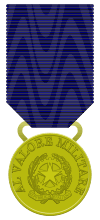Gold Medal of Military Valour
| Gold Medal of Military Valour Medaglia d'oro al valor militare | |
|---|---|
|
Italy's Gold Medal of Military Valour | |
| Country | Italy |
| Type | Military decoration |
| Eligibility | Junior officers and soldiers |
| Awarded for | Deeds of outstanding gallantry in war |
| Statistics | |
| Established | 21 May 1793 |
| Precedence | |
| Next (higher) | Military Order of Italy[1] |
| Next (lower) | Gold Medal for Army Valor[1] |
|
Ribbon bar of the medal | |
The Gold Medal of Military Valour (Italian: Medaglia d'oro al Valore Militare) is an Italian medal established on 21 May 1793 by King Victor Amadeus III of Sardinia "....per bassi ufficiali e soldati che avevano fatto azioni di segnalato valore in guerra" (for deeds of outstanding gallantry in war by junior officers and soldiers).
The face of the medal displayed the profile of the king, and on its reverse was a flag decoration and the words "al valore" (for valour).
On 14 August 1815, Victor Emmanuel I of Sardinia replaced it with the Military Order of Savoy ("l'Ordine militare di Savoia"), now known as the Military Order of Italy.
Charles Albert of Sardinia revived it on March 26, 1833, and added to it the Silver and Bronze medals. These had, on their faces, the coat of arms of Savoy with laurel branches, the royal crown, and the words "al valor militare" (for military valor). On the reverse were two laurel branches enclosing the name of the decorated soldier, and the place and date of the action.
With the proclamation of the Republic on June 2, 1946, the coat of arms of Savoy was replaced with the emblem of the Italian Republic.[2]
For actions performed by individuals during World War I, the Gold Medal was awarded some 368 times, as well as 37 times to military units, and once to the Unknown Soldier. Only four of the individual awards went to foreigners, one of these being Czar Nicholas II of Russia. The other three were for acts of gallantry in which the recipient was killed in action or died from his injuries (the Frenchmen John O'Byrne and Roland Morillot, and the American Coleman deWitt).[3] The Gold Medal of Military Valor was one of the most parsimoniously awarded medals of World War I, granted less frequently than even the Victoria Cross which was awarded 628 times.
During World War II the medal was awarded to soldiers of the Royal Italian Army; after these forces were reorganized following the Armistice with Italy in 1943, it was awarded to members of the Allies-supporting Italian Co-Belligerent forces. The Axis-affiliated Italian Social Republic created another design of the medal to give to members of the Esercito Nazionale Repubblicano from 1943 to 1945. This version of the award was not given recognition by the postwar Italian government.[4]
The Gold Medal for Military Valor is still awarded by the Italian state, and it, along with Silver and Bronze medals for Military Valor as well as the "Croce di Guerra al Valor Militare" (War Cross of Military Valour - which can only be awarded in time of war) is established by the Royal Decree of 4 November 1932, in which the purpose of these medals is defined as "To distinguish and publicly honor the authors of heroic military acts, even ones performed in time of peace, provided that the exploit is closely connected with the purposes for which the Armed Forces are constituted, whatever may be the condition or quality of the author."[5]
Notable recipients
- Domenico Millelire
- Francesco Baracca
- Cesare Battisti
- Annibale Bergonzoli
- Carmelo Borg Pisani
- Junio Valerio Borghese
- Carlo Emanuele Buscaglia
- Fulco Ruffo di Calabria
- Nicola Calipari
- Inigo Campioni
- Salvo D'Acquisto
- Unatù Endisciau, the only native soldier awarded of the Gold Medal
- Luigi Arbib Pascucci
- Carlo Fecia di Cossato
- Furio Niclot Doglio
- Emilio Faà di Bruno
- Luigi Giorgi
- Luigi Gorrini
- Giuliano Gozi, Captain-Regent of San Marino
- Amedeo Guillet
- Hans-Joachim Marseille
- Giulio Martinat
- Tito Minniti
- Joachim Müncheberg
- Sandro Pertini
- Luigi Reverberi
- Enrico Toti
- City of Naples
- Prince Maurizio Ferrante Gonzaga di Vescovato, Marquis of the Vodice (Twice)
- Luigi Rizzo
- Ciro Scianna (Private, IX Reparto d'Assalto)
- Dario Vitali (2nd Lieutenant, IX Reparto d'Assalto)
- Maurizio Zanfarino (1st Lieutenant, IX Reparto d'Assalto)
- Aurelio Rossi (Major, 187° Reggimento Fanteria Paracadutista "Folgore", he was also awarded 3 Silver Medals for Military Valor during the Great War as an Arditi officer)
- Gianfranco Paglia (1st Lieutenant, 183° Reggimento Fanteria Paracadutista "Nembo". Latest award to a living recipient.)
- Giuseppe Caimi
- Pore Mosulishvili
See also
- Silver Medal of Military Valor
- Bronze Medal of Military Valor
- List of prizes, medals, and awards
- Italian medals 1860-today (Italian Wikipedia)
References
- 1 2 "Esercito Italiano- Nastrini delle decorazioni in uso" (in Italian). Esercito.difesa.it. Retrieved 2012-05-30.
- ↑ Preceding paragraphs translated and adapted from http://bibliogo.ccm.it/index.php?page=View.DocDetail&id=742193 which describes the book "Le medaglie d'oro al valor militare: volume primo, Roma, [Gruppo Medaglie d'Oro al Valor Militare d'Italia], 1965, 804 p.; 22 cm"
- ↑ The website of the Italian Presidency: List of all recipients can be obtained by going to http://www.quirinale.it/elementi/onorificenze.aspx, going to "onorificenza" (under "Maschera di recerca"), selecting "Medaglia d'oro al valor militare" and pressing "avvia". Also see "Nel 1° Centenario della istituzione della Medaglia al Valor Militare" edizione del 1933 dell' Ufficio storico dell' esercito
- ↑ http://users.skynet.be/hendrik/eng/39italy.html
- ↑ "le Onorificenze - Medaglia e Croce di Guerra al Valor Militare" (in Italian). Quirinale.it. Retrieved 2012-05-30.
- Ceva, Bianca (1964). Cinque anni di storia italiana 1940-1945: da lettere e diari di caduti [Five Years of Italian History 1940 - 1945: Letters and diaries of the fallen]. Edizioni di comunità. pp. 143–144. OCLC 3658871.
